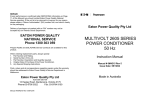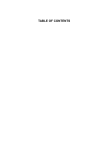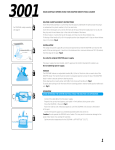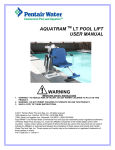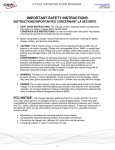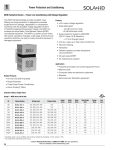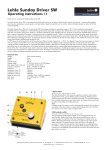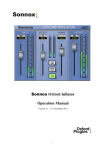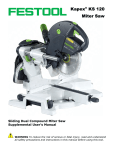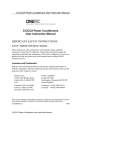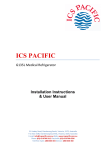Download Sola 26 User Manual 60Hz
Transcript
REPAIR If poor performance is confirmed (refer SERVICING information on Page 11 of this Manual) you should contact Eaton Power Quality National Service operation. If the unit is to be returned to Invensys for any reason, please obtain a “Return Authorisation” (RA) number first, and mark it clearly on the packaging. Delivery of packages not marked with an “RA” number may not be accepted by our Inwards Goods Department. EATON POWER QUALITY NATIONAL SERVICE Phone 1300 303 059 International Service +61 3 9706 5022 Prepaid Fastfix and SOLACARE Service Contracts are available for this product. When ordering replacement parts, always specify: 1. Part Number and Rating. 2. Serial Number of the unit. 3. Part Number, Description and Quantity required. 4. Original Date of Purchase of the Power Conditioner. 5. Any Special Shipping Instructions. Parts, orders and all correspondence regarding repairs under the warranty should be addressed to Eaton Power Quality’s Service Department in Melbourne. MULTIVOLT 2606 SERIES POWER CONDITIONER 60 Hz Instruction Manual Manual # 6M4214 Rev 7 Issue Date: 8 Aug. 2006 Eaton Power Quality Pty Ltd ACN 054 056 709 13 Healey Road, Dandenong, Victoria, Australia 3175 Phone:03-9706 5022 Fax: 03-9794 9150 Made in Australia Multivolt 2606 Power Conditioner Instruction Manual Multivolt 2606 Power Conditioner Instruction Manual Eaton Power Quality Pty Ltd INDEX ABN 82 054 056 709 Page No. SECTION ONE - General Description and Specifications 1.1 Introduction........................................................................................................................................ 1 1.2 General Description ........................................................................................................................... 1 1.3 Specification ...................................................................................................................................... 1 1.4 Safety Notice ..................................................................................................................................... 1 This Warranty is subject to Eaton Power Quality Pty Ltd (EPQ) standard Conditions of Sale, which govern all sales of products by Eaton Power Quality Pty Ltd. 1. EPQ products, in general, are warranted against failure due to faulty materials and/or workmanship for a period of two years from despatch date (ex EPQ store) as per invoice. The Ferroresonant and 95 Series Power Conditioners and Dry Type Transformers have an extended warranty - 5 years from date of despatch. The Transient Voltage Surge Suppression (TVSS) products are warranted against faulty materials and workmanship for certain periods from the date of purchase. Please refer to your equipment literature or catalogue for warranty periods. Please also note that it is possible that an excessive surge (such as from a direct lightning strike to the building or a building wiring fault) may cause damage to a unit and render it inoperable. In the case of filters/surge diverters, the units are designed to protect your equipment. However, due to the unpredictability of surge events, this is not a guarantee. A unit that has been damaged in this way is not warranted. 2. If, within the applicable Warranty period, any EPQ product does not meet the warranty specified above, and the product was installed and operated in accordance with EPQ recommended standard installation procedures, EPQ shall thereupon correct any defects due to faulty materials and/or workmanship. 3. Any modification made to the product other than those made by EPQ or its authorised representative may cause the Warranty to be void. 4. For units up to 3kVA that are installed as a portable device and TVSS products, the Warranty covers repair or replacement of defective parts at the factory, or other service locations as nominated by EPQ, provided the unit has been returned by the user packed adequately to prevent shipping damage, and approval has been obtained from EPQ before shipment. All costs associated with the return of the product to EPQ are at the customer's expense. For hardwired products 3kVA and above (except TVSS products), the Warranty covers on site repair (Metropolitan area, Capital Cities only), during normal working hours, by EPQ technicians or appointed agents. For units installed in remote locations, EPQ may, at its discretion, request the equipment to be recovered and returned to the factory or other nominated service locations. In this case, it is the customer's responsibility to pack the equipment adequately to prevent shipping damages and pay freight charges to the location nominated by EPQ. Approval to return goods must be obtained from EPQ before the goods are despatched. 5. Units returned for in-warranty repairs, which are found not to be defective, will be subject to an inspection and handling charge, plus transportation charges. 6. High grade batteries, designed for Uninterruptible Power Supply (UPS) applications, are supplied by EPQ for use with EPQ UPS equipment. These batteries have a finite life expectancy depending on a number of variables, including rate of discharge, depth of discharge, operating temperature, etc. 7. Providing that the batteries are used within the limits as set out in the battery manufacturer’s warranty statement and are provided as an integral part of new equipment, they are guaranteed for two years, from despatch date as per invoice. A copy of this warranty statement is available on request. Batteries provided as spare parts or replacements have a one year warranty. Other optional warranty terms for batteries are available on request. 8. EPQ reserves the right to charge for replacement batteries if within the one year guarantee period replacement batteries are necessary as a result of misuse or misapplication by the purchaser or end user. SECTION TWO - Installation Mechanical ........................................................................................................................................ 2 Electrical ............................................................................................................................................ 4 Multiple Operation.............................................................................................................................. 6 Input Power Switch ............................................................................................................................ 6 Neutral to Ground Bonding ................................................................................................................ 6 2.1 2.2 2.3 2.4 2.5 SECTION THREE - Physical Characteristics of Operation 3.1 Operating Temperature...................................................................................................................... 8 3.2 Magnetic Fields.................................................................................................................................. 8 SECTION FOUR - Electrical Characteristics of Operation Checking with Voltmeters .................................................................................................................. 9 Load Regulation................................................................................................................................. 9 Effect of Load Power Factor .............................................................................................................. 9 Use with Switchmode Power Supplies ............................................................................................... 9 Effect of Temperature ........................................................................................................................ 10 Response Time.................................................................................................................................. 10 Input Characteristics .......................................................................................................................... 10 Current Limitation .............................................................................................................................. 10 Operation on Motor Loads ................................................................................................................. 10 4.1 4.2 4.3 4.4 4.5 4.6 4.7 4.8 4.9 SECTION FIVE - Servicing 5.1 Servicing.............................................................................................................................................. 11 1. 2. 3. FIGURES Power Conditioner Dimensions.......................................................................................................... 3 Power Conditioner Schematic............................................................................................................ 5 Change in “Median” Output Voltage vs Load Power Factor ............................................................... 9 1. 2. 3. 4. 5. 6. 7. TABLES Dimensions 500VA – 5000VA............................................................................................................ 2 Dimensions 10000VA – 15000VA...................................................................................................... 2 Bolt Sizes........................................................................................................................................... 4 Input Connections.............................................................................................................................. 4 Output Connections ........................................................................................................................... 4 Recommended Breaker or Fuse ........................................................................................................ 6 Recommended minimum wire size .................................................................................................... 7 REF: WARRANTY.DOC Rev 9 Effective Date: January 2004 Multivolt 2606 Power Conditioner Instruction Manual Multivolt 2606 Power Conditioner Instruction Manual SECTION ONE - GENERAL DESCRIPTION AND SPECIFICATIONS 1.1. INTRODUCTION This manual is relevant to Multivolt Power Conditioners. These units require no complicated commissioning or maintenance procedures and will provide many years of trouble-free operation. This manual provides descriptive information, operation and maintenance instructions. 1.2 GENERAL DESCRIPTION The Multivolt Power Conditioners provide instantaneous voltage regulation and isolation from both transverse and common mode noise. They also suppress transients, protect from overloads and serve as a portable dedicated line. They are the ultimate in AC power conditioning equipment. Multivolt hardwired units, rated 500 to 15000VA, are designed to be permanently installed by qualified electricians. 1.3 This page intentionally left blank. SPECIFICATIONS Operating Temperature Range: -20o to +50oC Phase: Single Frequency: 60 Hz Input Voltage: 120, 208, 240, 480V (Refer Table 4) Output Voltage: 120, 208, 240 VAC (Refer Table 5) Output Voltage Regulation: +3% for an input line variation of + 10%, - 20% Output Harmonic Distortion: Less than 3% Efficiency: 85% at full load Dropout: No loss of output for line loss of 3msec Common Mode Noise Rejection: Greater than 120dB Transverse Mode Noise Rejection Greater than 60 dB Safety Approvals: Designed and built per: Low Voltage Directive 73/23/EEC Electromagnetic Compatibility 89/336/EEC IEC726, IEC76 UL1446, UL1012 UL Listed. File E140815 1.4 SAFETY NOTICE High voltages are present inside the Power Conditioner. Do not reach inside the unit when it is energised. To measure voltage, de-energise the unit, connect the meter and then re-energise the unit. - 12 – -1- Multivolt 2606 Power Conditioner Instruction Manual Multivolt 2606 Power Conditioner Instruction Manual SECTION FIVE - SERVICING SECTION TWO - INSTALLATION 5.1 2.1 Table 1 and 2 show the physical dimensions of the Power Conditioners. These units MUST be mounted in either one of two ways: a) b) Vertically on a wall with the “THIS SIDE UP” designation facing upwards, or, Horizontally on a flat surface. Part No. Outline Drawing DIM G in/mm DIM H in/mm DIM J in/mm APPROX SHIPPING WEIGHT lb/kg 500 2606-0500M A 15/381 3.2/81 3.4/85 0.4 x 0.8/ 10 x 20 1/25.4 44/20 1000 2606-1000M A 9.1/232 4.8/122 6.2/158 0.4 x 0.8/ 10 x 20 1/25.4 62/28 2000 2606-2000M 9.6/244 11.3/288 12.8/325 11.9/303 4.1/104 5.1/129 0.4 x 0.8/ 10 x 20 1.4/35 106/48 3000 19.2/487 9.6/244 11.3/288 12.8/325 11.9/303 6.2/158 5.1/129 0.4 x 0.8/ 10 x 20 1.4/35 143/65 5000 29.6/751 9.6/244 11.3/288 12.8/325 11.9/303 9/228 5.1/129 0.4 x 0.8/ 10 x 20 1.4/35 234/106 DIM A DIM B in/mm in/mm DIM C in/mm DIM D in/mm DIM E DIM F in/mm in/mm 6.4/162 7.9/200 10/254 9.1/232 18.9/481 6.7/170 7.9/200 10/254 B 19.2/487 2606-3000M B 2606-5000M B Table 1. Dimensions 500VA – 5000VA VA Part No. Outline Drawing 10000 02606-10KM C 29.6/751 9.6/244 24.8/630 26.9/683 26/660 15000 02606-15KM D 29.6/751 9.6/244 38.9/987 44.9/1140 44/1117 DIM A DIM B in/mm in/mm DIM C in/mm DIM D in/mm Output Voltage too low. Does not regulate Output Voltage closely. Output Voltage very low. No Output Voltage Transformer Operating Temperature DIM G in/mm DIM H in/mm DIM J in/mm APPROX SHIPPING WEIGHT lb/kg 9/228 5.1/129 0.4 x 0.8/ 10 x 20 1.4/35 474/215 9/228 5.1/129 0.4 x 0.8/ 10 x 20 1.4/35 706/320 DIM E DIM F in/mm in/mm Since Multivolt Power Conditioners are simple, rugged devices without moving parts or printed circuit boards no adjustments, servicing or maintenance is required in the normal sense. If poor performance is suspected, the user is urged to check the following points immediately. Fault Output Voltage too high. In both cases, there must be a minimum of 23.6inches/600mm clearance above the unit, plus a minimum of 11.8inches/300mm around all sides. Note that the shipping weights of the 10,000 and 15,000VA units mandate that vertical mounting of these units be on masonry or steel reinforced walls only. The minimum recommended size of mounting bolts is given in Table 3. Ensure that the fixings and support structure will safely support the additional weight. VA SERVICING MECHANICAL NOTE: 1. 2. 3. Table 2. Dimensions 10000VA – 15000VA Possible Cause • The load may be considerably less than full rating (See “Load Regulation” Page 9.) • The load may have a leading power factor. • Load power factor may be lagging. • Unit may be slightly overloaded (See “Current Limitation”, Page 10.) • Input voltage too low. • Input connections incorrect (See Table 4). • Unit may be slightly overloaded (See “Current Limitations”, Page 10.) • Actual line voltage swings may be outside the rated range of unit, particularly on low side. • On varying loads, a certain amount of load regulation may be mixed with the line voltage regulating action (See “Load Regulation”, Page 9). • Input connections incorrect (See Table 4). • Unsuspected or unplanned overloads of substantial size may occur intermittently (motor-starting currents, solenoid inrush currents, etc.) (See “Current Limitation”, Page 10.) • One or more capacitor units in regulator may be defective. • Input voltage too low. • Input connections incorrect (See Table 4). • Check power source breakers or fuses. • Check continuity between input terminals and also between output terminals. • The transformer used in these Power Conditioners is designed to operate at high flux density, and hence, relatively high temperatures. After connection to line for a half hour or so, the transformer core structure may be too hot to touch with the bare hand. This is normal and need give no concern. In case the Power Conditioner is operating but does not appear to have the correct output, ................... Disconnect the working load. Connect a dummy load of lamps, heaters, or other resistive loads substantially equal to the full load rating of the Power Conditioner, directly across its output terminals. Measure the output voltage of the Power Conditioner using a true R.M.S. type voltmeter at the output terminals. This test will usually establish whether the apparent poor performance is due to a fault in the Power Conditioner or to some peculiarity of the working load. -2- - 11 - Multivolt 2606 Power Conditioner Instruction Manual 4.5 Multivolt 2606 Power Conditioner Instruction Manual EFFECT OF TEMPERATURE The output voltage will show a small change as the unit warms up to stable operating temperatures at a constant ambient temperature. This change may be about one or two percent, depending on the unit’s VA rating. At a stable operating temperature, the output voltage will change slightly with varying ambient temperature. This shift is approximately one percent for each 40oC of temperature change. 4.6 RESPONSE TIME An important advantage of the Invensys principle of static magnetic regulation is its fast response time, compared to other types of AC regulators. Transient changes in supply voltage are usually corrected within 11/2 cycles or less; the output voltage will not fluctuate more than a few percent. 4.7 INPUT CHARACTERISTICS The Power Conditioner transformer includes a resonant circuit which is energised whether it is supplying a load or not. The input current at no load is approximately 35% of the full load primary current. Input power factor will average 0.9 - 1.0 at full load, but may drop to about 0.75 at half load and 0.25 at no load. It is always leading. 4.8 CURRENT LIMITATION When the load is increased beyond the Power Conditioner’s rated value, a point is reached where the output voltage suddenly collapses and will not regain its normal value until the load is partially released. Under short circuit conditions, the load current is limited to approximately 150% of the rated full load value, and the input power to less than 10% of normal. The Power Conditioner will protect both itself and its load against damage from excessive fault currents. 4.9 OPERATION ON MOTOR LOADS Because of the current-limiting effect described above, special attention should be given to motor applications. In general, the Power Conditioner must have a load rating nearly equal to the maximum power drawn during the starting cycle. This may run from two to eight times the normal (running) rating of the motor. In doubtful cases, it is advisable to measure the actual starting current. Figure 1 - Power Conditioner Dimensions (Refer to Table 1) Knockout Locations are typical. - 10 - -3- Multivolt 2606 Power Conditioner Instruction Manual Multivolt 2606 Power Conditioner Instruction Manual SECTION FOUR - ELECTRICAL CHARACTERISTICS OF OPERATION Table 3 shows the recommended bolt sizes for mounting these hardwired units. 4.1 Minimum Recommended Size of Steel Mounting Hardware 5/16 or M8 3/8 or M10 15000 1/2 or M12 4.2 4.3 ELECTRICAL Multivolt Power Conditioners may be configured for different input and output voltages simply by connecting input and output leads to the appropriate terminals on the input/output terminal block, which is located beneath an access panel in one end of the unit. Figures 2 and 3 show the schematic diagram of the units. Input Voltage Input Terminals (0.5 – 5kVA) H1 and H2 - 208 H1 and H3 H1 and H2 240 H1 and H4 H1 and H3 H1 and H5 H1 and H4 Table 4. Input Connections Output Voltage Output Connections 120 X1 and X3 OR X3 and X5 208 X2 and X4 240 X1 and X5 Table 5. Output Connections NOTE: 120V load may be connected between either or both of the terminals listed, however the total nameplate VA of the unit must not be exceeded EFFECT OF LOAD POWER FACTOR The median value of output voltage will vary from the nameplate rating if the load has a power factor other than that for which the regulator was designed. Load regulation will also be greater as the inductive load power factor is decreased. The resulting median values of output voltage will be regulated against supply line changes at any reasonable load or load power factor. Figure 4 illustrates this effect. Input Terminals (10 – 15kVA) 120 480 LOAD REGULATION Changes in output voltage resulting from changes in resistive load from no load to full load (at a 1.0 power factor) are approximately -4%. Table 3 - Bolt Sizes 2.2 All checks on output voltages should be made with a true R.M.S. voltmeter. Rectifier type voltmeters will not give accurate readings due to the small amount of output harmonic distortion which is present. Rating 500/1000 2000 to 10000 CHECKING WITH VOLTMETERS Output Voltage % of Nominal Rated VA of Unit 100 98 96 94 92 90 88 50% Load 75% Load 100% Load 1 0.9 0.8 0.6 0.5 Load P ow er Factor (Inductive) Figure 4 - Change in “Median” Output Voltage versus Load Power Factor at various loads 4.4 USE WITH SWITCHMODE POWER SUPPLIES If a Power Conditioner is used as a source for a switchmode power supply, a slight amount of ringing may be noticed on the sine wave output of the Power Conditioner at half cycle intervals for a short duration. This ringing occurs at the point when the switchmode power supply current demand drops to zero. The ringing need not be a cause for concern, since it is of relatively low magnitude and frequency. The Power Conditioner has been tested with a variety of switchmode power supplies and it has been determined that the ringing does not affect the DC output, nor has it been found to degrade the components of any switchmode power supply. -9-4- 0.7 Multivolt 2606 Power Conditioner Instruction Manual Multivolt 2606 Power Conditioner Instruction Manual SECTION THREE - PHYSICAL CHARACTERISTICS OF OPERATION 3.1 OPERATING TEMPERATURE Multivolt Power Conditioners are designed to operate in ambient temperatures of -20oC to +50oC. In operation, a temperature rise will occur whether or not the Power Conditioner is supplying a load. This rise may be anywhere in the range of 45-100oC, depending on the Power Conditioner type and rating. The maximum operating temperature at an ambient of 50oC is always within safe operating limits. 3.2 MAGNETIC FIELDS In almost all applications, this effect may be disregarded. In certain applications, care should be exercised in the orientation of the core with respect to critical circuits, in order to minimise the effect of the magnetic field. Applications requiring care may include: • • Proximity to Monitor and C.R.T. Proximity to magnetic storage media Figure 2. Power Conditioner Schematic -8 - -5- Multivolt 2606 Power Conditioner Instruction Manual Multivolt 2606 Power Conditioner Instruction Manual Tables 6 and 7 show recommended Breaker (or Fuse) and wire sizes for the Power Conditioners. This table is not meant to supersede local and national wiring codes and standards. Make certain to adhere to local and national code requirements. Rated Voltage Input Input Current 120 208 240 480 Output Rated Rated Watts Voltage (PF=1) Minimum Breaker 1 Size Rated VA 5.8 3.3 2.9 1.4 15 15 15 15 500 120 208 240 480 10.0 5.8 5.0 2.5 15 15 15 15 1,000 2606-2000M 120 208 240 480 23.1 13.3 11.5 5.8 30 20 15 15 2,000 2,000 120 208 240 16.7 9.7 8.4 2606-3000M 120 208 240 480 30.0 17.5 15.0 7.5 40 25 20 15 3,000 3,000 120 208 240 25.0 14.5 12.5 120 208 240 480 57.6 33.3 28.8 14.4 80 45 40 20 5,000 208 240 480 66.5 57.6 28.8 90 80 40 10,000 208 240 480 99.7 86.4 43.2 125 110 60 15,000 Part No. 2606-0500M 2606-1000M 2606-5000M 2606-10KM 2606-15KM 500 1,000 Recommended Minimum Wire Sizes 4.2 2.4 2.1 120 208 240 8.4 4.8 4.2 o 90 C (194 F) Copper Wire Size 15A, 20A 12 AWG (3.3mm2) 25A, 30A 10 AWG (5.3mm2) Output Current 120 208 240 o Input Circuit Breaker Size 35A, 40A, 45A, 50A 8 AWG (8.4mm2) 60A 6 AWG (13.3mm2) 70A, 80A 4 AWG (21.2mm2) 90A, 100A 3 AWG (26.7mm2) 110A 2 AWG (33.6mm2) 125A 1 AWG (42.1mm2) 150A 1/0 AWG (53.5mm2) Table 7: Recommended Minimum Wire Size 2.3 MULTIPLE OPERATION Two or more models of the same rating may be connected with their input and output in parallel. Do not parallel both 208V (x2-x3-x4) and 240V (x1-x3-x5) tappings. This may damage the output windings. 5,000 10,000 15,000 120 208 240 41.7 24.0 20.8 120 208 240 83.3 48.1 41.7 120 208 240 125 72.1 62.5 2.4 INPUT POWER SWITCH Because the Power Conditioners include resonant circuitry that is energised, whether or not the unit is serving a load, it is desirable to install an isolator in the primary circuit. Normally this isolator should be mounted near the Power Conditioner. 2.5 NEUTRAL TO GROUND BOND (or M.E.N. LINK) Multivolt Power Conditioners are supplied ready for wiring. As the secondary circuit is floating with respect to Ground, we recommend that the secondary circuit be tied to Ground at one point only. For 120V systems, terminal X3 may be linked to Ground, for 208 and 240V systems, either terminals X2 or X4, or terminals X1 or X5 may be linked to Ground. (See figure 2, Page 5.) Table 6: Recommended Breaker or Fuse For U.S.A. 120, 208 and 240V systems, link terminal X3 to Ground. (See figure 2, Page 5.) Notes: 1. Use a time delay type circuit breaker or fuse. -6- -7-








